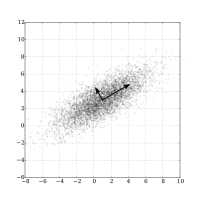
Photo from wikipedia
Abstract Since the outdoor and indoor load conditions always change continuously, it may lead to the various operation characteristics in chillers. If a single principal component analysis (PCA) model is… Click to show full abstract
Abstract Since the outdoor and indoor load conditions always change continuously, it may lead to the various operation characteristics in chillers. If a single principal component analysis (PCA) model is applied to detect and diagnose sensor faults under a wide range of chiller operation conditions, the various operation characteristics may confuse the sensor fault analysis process in two aspects. One is that the single PCA model may not be sensitive enough to detect less server faults due to the inadaptable and fixed fault detection boundary; the other is that the single PCA model can hardly distinguish some new normal operation conditions from serious sensor faults since it is impossible for a training PCA model to cover all chiller operation conditions. To overcome the limitations, this study proposed an improved sensor fault detection, diagnosis and estimation (FDD&E) method combining density-based clustering with PCA. Clustering analysis, i.e., the Density-Based Spatial Clustering of Applications with Noise (DBSCAN) can automatically classify operation data into clusters and recognize the corresponding operation conditions. Instead of a single PCA model, using sub-PCA models to describe each normal operation condition improved the sensitivity and reliability of fault detection and diagnosis as well as the accuracy of sensor fault estimation. The proposed method was validated using field operation data of an existing screw chiller plant while various sensor faults of different magnitudes were introduced. Results reveal that the proposed method shows better sensor FDD&E results than conventional PCA-based sensor FDD&E method using a single PCA model.
Journal Title: Energy and Buildings
Year Published: 2018
Link to full text (if available)
Share on Social Media: Sign Up to like & get
recommendations!